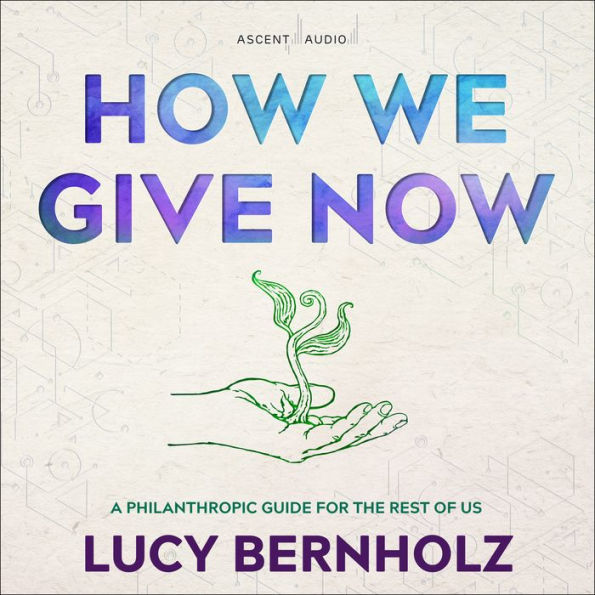2022 PROSE Award Winner, Economics
“How We Give Now offers anyone interested in a fuller understanding of how we participate in society, whether it be with our time, money, or data, a lot to consider — about what our shared futures can look like, if we were to pause to think more deeply about how we do things.”
—Philanthropy News Digest
“Dr. Lucy Bernholz has written the most important book on philanthropy this year… Bernholz’s biggest contribution with this book is the demonstration of how much generosity is happening outside the transaction of writing a cheque to a charity, and how much oxygen is taken up in the charity sector by this narrow framework.”
—The Charity Report
"An impressively thought-provoking and inspiring work, this timely synthesis of ideas and practicality has relevance for public policy, economics, sociology, the sciences, and more. Anyone interested in contributing to the greater good should consider reading it."
—CHOICE
In How We Give Now, Lucy Bernholz shows that philanthropy is more than writing a check and claiming a tax deduction. For most of us-the non-wealthy givers-philanthropy can be a way of living our values and fully participating in society. We give in all kinds of ways-shopping at certain businesses, canvassing for candidates, donating money, and making conscious choices with our retirement funds. We give our cash, our time, and even our data to make the world a better place.
Donating our digitized personal data is an emerging form of philanthropy, and Bernholz describes safe, equitable, and effective ways of doing so-giving genetic data for medical research through a nonprofit genetics organization rather than a commercial one, for example, or contributing photographs to an online archive like the Densho Digital Repository, which documents America's internment of 120,000 Americans of Japanese descent. Bernholz tells us to "follow the money," however, when we're asked to "add a dollar" to our total at the cash register, or when we buy a charity-branded product; it's more effective to give directly than to give while shopping.
Giving is a form of participation. Philanthropy by the rest of us-across geographies and cultural traditions-begins with and builds on active commitment to our communities.
"1138287525"
Donating our digitized personal data is an emerging form of philanthropy, and Bernholz describes safe, equitable, and effective ways of doing so-giving genetic data for medical research through a nonprofit genetics organization rather than a commercial one, for example, or contributing photographs to an online archive like the Densho Digital Repository, which documents America's internment of 120,000 Americans of Japanese descent. Bernholz tells us to "follow the money," however, when we're asked to "add a dollar" to our total at the cash register, or when we buy a charity-branded product; it's more effective to give directly than to give while shopping.
Giving is a form of participation. Philanthropy by the rest of us-across geographies and cultural traditions-begins with and builds on active commitment to our communities.
How We Give Now: A Philanthropic Guide for the Rest of Us
In How We Give Now, Lucy Bernholz shows that philanthropy is more than writing a check and claiming a tax deduction. For most of us-the non-wealthy givers-philanthropy can be a way of living our values and fully participating in society. We give in all kinds of ways-shopping at certain businesses, canvassing for candidates, donating money, and making conscious choices with our retirement funds. We give our cash, our time, and even our data to make the world a better place.
Donating our digitized personal data is an emerging form of philanthropy, and Bernholz describes safe, equitable, and effective ways of doing so-giving genetic data for medical research through a nonprofit genetics organization rather than a commercial one, for example, or contributing photographs to an online archive like the Densho Digital Repository, which documents America's internment of 120,000 Americans of Japanese descent. Bernholz tells us to "follow the money," however, when we're asked to "add a dollar" to our total at the cash register, or when we buy a charity-branded product; it's more effective to give directly than to give while shopping.
Giving is a form of participation. Philanthropy by the rest of us-across geographies and cultural traditions-begins with and builds on active commitment to our communities.
Donating our digitized personal data is an emerging form of philanthropy, and Bernholz describes safe, equitable, and effective ways of doing so-giving genetic data for medical research through a nonprofit genetics organization rather than a commercial one, for example, or contributing photographs to an online archive like the Densho Digital Repository, which documents America's internment of 120,000 Americans of Japanese descent. Bernholz tells us to "follow the money," however, when we're asked to "add a dollar" to our total at the cash register, or when we buy a charity-branded product; it's more effective to give directly than to give while shopping.
Giving is a form of participation. Philanthropy by the rest of us-across geographies and cultural traditions-begins with and builds on active commitment to our communities.
19.99
In Stock
5
1

How We Give Now: A Philanthropic Guide for the Rest of Us

How We Give Now: A Philanthropic Guide for the Rest of Us
FREE
with a B&N Audiobooks Subscription
Or Pay
$19.99
19.99
In Stock

Editorial Reviews
Product Details
| BN ID: | 2940176051124 |
|---|---|
| Publisher: | Ascent Audio |
| Publication date: | 10/12/2021 |
| Edition description: | Unabridged |
Videos

From the B&N Reads Blog
